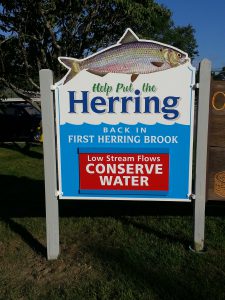Summary of Public Goals
The town of Scituate and the NSRWA are working together on a project to raise the reservoir by 1.5 feet. This project will accomplish several important public goals:
- Provide drought resiliency by adding 25 additional days of water storage;
- Allow for fish ladder improvements needed to reconnect the habitat for river herring and eels (both species of concern); and
- Bring the reservoir dam up to today’s flood passage standards.
This one project will make both people and nature more resilient to a changing climate.
To read the full text of our comment letter click here. To read the Draft Environmental Impact Report click here.
Background
The Town of Scituate receives 80% of its municipal water supply from the First Herring Brook watershed. The town Reservoir and Old Oaken Bucket Pond are part of the First Herring Brook. After leaving Old Oaken Bucket Pond, the First Herring Brook enters the Herring River at the Driftway and from there flows into the North River. Water withdrawals, dams, and an increasingly developed watershed have impacted natural stream flows, limiting its ability to support migratory fish like herring.
Since 2007, the Town has worked with the NSRWA and its partners to create a multi-pronged approach to balancing municipal water demand and ecological flow requirements, with the end goal of restoring more natural conditions and providing adequate flow for herring migration. Since implementing flow requirements and making improvements to the Old Oaken Bucket Fish ladder our herring counters have documented small numbers of fish returning each spring after decades of no herring at all.
Current Work
While Old Oaken Bucket Pond is accessible for river herring, fish are still unable to access the 75 acres of potential spawning habitat above the reservoir dam. In order to restore that connection for the fish the town and the NSRWA are working together on a project to raise the reservoir by 1.5 feet.
History of Project
The First Herring Brook Restoration Project began in earnest with a modeling effort in 2007 that involved many local, state, and federal partners. The water resources in the First Herring Brook were modeled by the Nature Conservancy and the Massachusetts Division of Ecological Restoration (MassDER) using the Water Evaluation and Planning Model (WEAP), developed by the Stockholm Environment Institute.
 Irrigation Restriction
Irrigation Restriction
As part of the restoration effort, the Town of Scituate, with support from the NSRWA, created a watering restriction in 2011 that allows households on town water supply to use outdoor irrigation systems one day a week from Memorial Day to Labor Day with a goal of consistently providing more water in the surface water system in late summer and fall. Since implementing the restriction, the town has saved ~300,000 gallons/day each summer.
Water Division Operational Plan
Scituate started releasing streamflow from the Reservoir and Old Oaken Bucket Pond in October of 2011 according to an agreed upon operational plan that allows for more natural streamflow downstream of the dams. During each season (or bioperiod) the town releases enough water to meet a streamflow that would occur or be exceeded 90% of the time. This has provided adequate, though low, flow year-round for natural stream processes and the migration of river herring, except during periods of drought. Data on the success of the operational plan is collected by the NSRWA and MassDER through a combination of stream gauges and water level loggers.
Fish Ladder and Reservoir Improvements
The Town of Scituate has received multiple MassDEP Sustainable Water Management Initiative (SWMI) grants to study ways to make improvements to the ability of its dams to pass fish while also conserving water. In 2013, the grant focused on installing weirs in the Old Oaken Bucket fish ladder, preliminary design of improvements to the Reservoir dam and fish ladder, and analysis of the benefits of increasing the Reservoir elevation. In 2014, the grant focused on further investigation into improvements to the Reservoir dam and fish ladder and the potential to increase its elevation, including survey, groundwater level monitoring, and agency and public outreach. In 2017 and 2018 further funding was obtained for design and permitting to raise the reservoir and improve fish passsage. In 2019 a Draft Environmental Impact Report was published. The town and NSRWA are currently seeking funds to finalize permits and start construction. All told the town has been the recipient of over $465,000 in state grants in support of this project.
- 2025 WaterWatch Lecture Series
- Education
- 2024 WaterWatch Lecture Series
- Community Programs
- Estuary Explorers
- River Adventures Camp
- School Programs
- Workshops and Conferences
- Healthy Rivers
- Dam Removals
- Indian Head River Restoration
- South River Restoration
- South River Restoration
- Third Herring Brook Restoration
- Improving Water Quality
- Shellfish Beds
- Streamflow Restoration
- First Herring Brook Restoration
